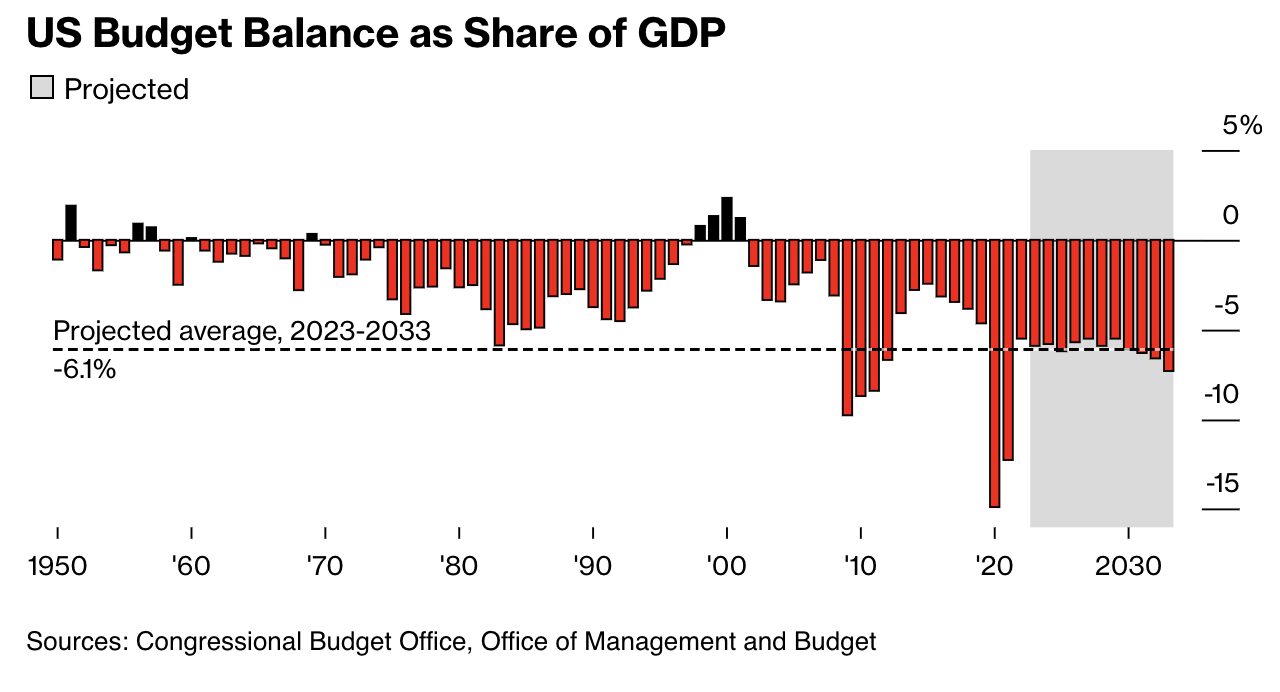Bloomberg's data suggests that the current scenario for the federal budget is truly unparalleled. Massive deficits loom in the forecast, despite a seemingly healthy economy. This has left investors on edge, evident from the 10-year Treasuries soaring past 4.3%, a peak not seen since 2007. Concurrently, the 30-year fixed mortgage rate has shot beyond 7%, a figure untouched in over two decades.
Investor apprehensions stem from the Congressional Budget Office's projections. Prolonged fiscal imbalances of the current magnitude could escalate rates even more, further straining public finances. Anxiety grew this month when the US Treasury augmented its debt issuance and to the surprise of many, Fitch Ratings downgraded the US sovereign credit rating.
Wall Street's longstanding debate over the nation's fiscal practices has taken a new turn, as observed by Bloomberg. The current deficit spike, which has surged to $1.6 trillion within 10 months, mirrors the governmental response to a recession. However, contradicting many forecasts, the economy is still expanding.
Although global governments are also increasing their borrowings and expenditures, the US's financial influx stands out in its magnitude and consistency. With policies ranging from Trump's tax slashes to Biden's industrial support, both major parties appear more inclined to stimulate growth via fiscal means rather than relying solely on the Federal Reserve. Thus, a significant bipartisan approach to deficit reduction seems unlikely in the near future.
Oksana Aronov of J.P. Morgan Asset Management remarks, as noted in Bloomberg's findings, that with a robust economy and low unemployment, there's little drive among American policymakers for a shift in strategy. She emphasizes the unprecedented fiscal expenditure in peacetime, which is driving higher long-end rates.
Comment: The US hasn't experienced 'peacetime' for decades, and maybe even a century.
One prominent reason for the escalated borrowing costs, according to Bloomberg's analysis, is the Federal Reserve's consistent interest rate hikes over the past 18 months to curb inflation. While many believe this aggressive monetary policy might soon relax, upcoming comments from Fed Chair Jerome Powell could disrupt this assumption.
Furthermore, Bloomberg's analytics show that the Biden administration's heavy fiscal spending might reignite inflation, complicating the Federal Reserve's efforts to reduce interest rates.
Despite high-profile debates on budget allocations, there's a bipartisan reluctance to reduce entitlements or hike taxes on households and businesses. To add to the deficit concerns, emergency funding is being considered for the Ukraine conflict and disaster relief, alongside potential tax cuts by the House's Republican majority.
In conclusion, Bloomberg's assessment, based on data from the nonpartisan Congressional Budget Office, indicates that the deficit might hover around 6% of the GDP for the upcoming decade. For perspective, such levels were unseen in the six decades between World War II's aftermath and the 2008 financial crisis.




Comment: It's likely that the economic situation will only worsen, and that US will be forced to admit that they've not lost the proxy war in Ukraine but they've wasted over a $100 billion on it, and it's possible that the establishment will soon feel it needs to resort to desperate measures to distract from these facts: